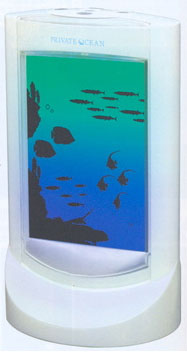 CScout Japan reported on 30 June 2007 they saw Sega Toys’ new Private Ocean at the Tokyo Toy Show. Somewhat similar to Ant’s Life Studio, but it has over 100 different ocean creatures. Private Ocean becomes your own private ocean. You can change the background and the screen is backlit if different colors. It includes touch sensors (touching the top sensor gets the fish to swim together and spell out the date and time, touching the bottom sensor scares them off.
CScout Japan reported on 30 June 2007 they saw Sega Toys’ new Private Ocean at the Tokyo Toy Show. Somewhat similar to Ant’s Life Studio, but it has over 100 different ocean creatures. Private Ocean becomes your own private ocean. You can change the background and the screen is backlit if different colors. It includes touch sensors (touching the top sensor gets the fish to swim together and spell out the date and time, touching the bottom sensor scares them off.
It is somewhat of a small virtual aquarium featuring ocean life in the wild.
If you connect and MP3 player or i-Pod, the fish dance to the music.
They report Private Ocean is to be released in October 2007.
Posted in Fish, Musical | Comments Off on Private Ocean from Sega Toys
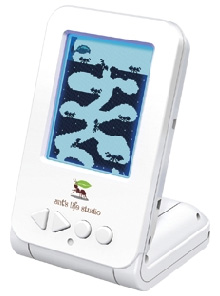 In 2006 Bandai released Ant’s Life Studio, a small desktop virtual ant farm, reminiscent of the famous Uncle Milton’s Ant Farms from years ago when you used to buy them in the store and mail in a coupon to have the ants sent to you. Except this version has virtual ants and you care for them.
In 2006 Bandai released Ant’s Life Studio, a small desktop virtual ant farm, reminiscent of the famous Uncle Milton’s Ant Farms from years ago when you used to buy them in the store and mail in a coupon to have the ants sent to you. Except this version has virtual ants and you care for them.
The companion web site teaches you some about the life of real ants (in Japanese).
Posted in Uncategorized | Comments Off on Ant’s Life Studio from Bandai

Tomy has a therapeutic pet for those with health or medical difficulties called Healing Partner Dacky. He has several sensors and can talk to his owner in Japanese.
Posted in Plush Pets, Therapy Pets | Comments Off on Healing Partner Dacky from Takara Tomy
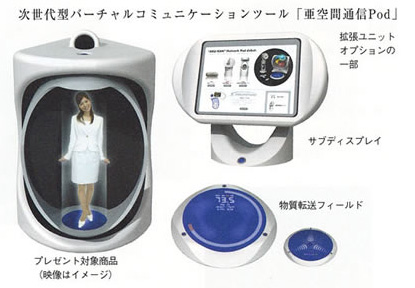
Frepar Networks in Japan will be releasing an interactive 3D display called a “POD” in which a virtual person can “read” newsfeeds and other content to the user. You can actually engage in a discussion with the character using the SAMURAIPHONE. Plus the virtual person responds to touch and you can even blow on them and make it windy in there.
Virtual human (and potentially virtual pets) are coded into a “CODEC CELL” that is inserted into the POD. If you want a new character, get a different CODEC CELL.
An “Interface Station” allows the system access to network interfaces, digital broadcasting, and digital electronic appliances. The “Sub-Display” is used for to select the “feed” for real time display and to display information about the character (and advertisements). A “Satellite Dish” is actually a local wireless LAN station with an internal WiFi antenna. SAMURAIPHONE can be used to make free calls within the area via IP.
The “CMOS Camera Unit” is for user authentification and voice recognition. It can be combined with the Satellite Dish.
You can use the Material Transfer Fields MTF200 and MTF300 to transfer materials to the character (food, costumes, medicine). The MTF350 is also linked to the weight measuring and diet programs (you can put you character on a diet or fatten them up). Material transfer is done by scanning bar codes. Some special ones are supplied for clothing, but you can just go to your cupboard and get a scan of food and scan it. She will eat it if she is hungry. The virtual character can also teach you the English language. Some suspect other bar coded will be distributed via magazines and other means if it takes off.
The entire system is called a Sub-Spacial Communication Pod and is expected to be released by the end of 2007 for about $250 in Japan.
Microsoft will be using the system to supply product information support to its 2007 Office software in Japan.
Posted in Instructional, People | Comments Off on Frepar Networks POD to Allow 3D Interaction
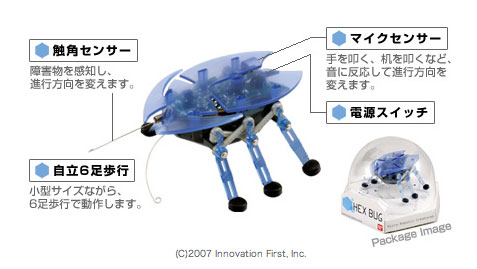
Bandai will shortly be releasing five little see through, walking virtual insects called Hex Bug. Bandai refers to them as Micro Robotic Creatures. Hex Bugs recognize when their feeler antennae hit something and turn away from the obstruction. Plus if you clap your hands, they will change direction.
They name them by color. Charley is blue, Echo is red, Bravo is green, Delta is yellow, and Alpha is orange.
HexBug is available in the U.S. from Radio Shack and hexbug.com .
A robotics group is offering a $6,000 prize for the first photo of a special edition Gold HexBug (only one was made) along with the secret code from the bottom of its box. The Gold HexBug is in an undisclosed Radio Shack store in the U.S.
Posted in Robotic Pets | Comments Off on Hex Bug From Bandai
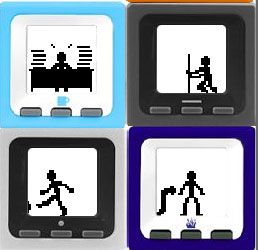 While some are pushing virtual pets toward the “Uncanny Valley” where they seem so real they become eirie and people back away from them, Bandai took the opposite tack with its Cube World released in late 2005. Little stick people repesented by only a few pixels live, work and play in each cube. Once connected together, they can interact with their neighbors. Meant for desktop amusement, the “humans” know which way is up and fall when you tilt or shake their cube. They are a bit reminiscent of Activision’s, Little Computer People, except Activision’s game was in color.
While some are pushing virtual pets toward the “Uncanny Valley” where they seem so real they become eirie and people back away from them, Bandai took the opposite tack with its Cube World released in late 2005. Little stick people repesented by only a few pixels live, work and play in each cube. Once connected together, they can interact with their neighbors. Meant for desktop amusement, the “humans” know which way is up and fall when you tilt or shake their cube. They are a bit reminiscent of Activision’s, Little Computer People, except Activision’s game was in color.
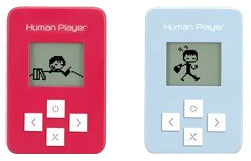 Bandai is now following up Cube World with Human Player. This time, the product is a handheld, and you are the pet. The game asks you about 50 questions about yourself, picks one of 22 personalities to represent you, and can interact with other characters inside your device or with other Human Players via an infrared link.
Bandai is now following up Cube World with Human Player. This time, the product is a handheld, and you are the pet. The game asks you about 50 questions about yourself, picks one of 22 personalities to represent you, and can interact with other characters inside your device or with other Human Players via an infrared link.
Both games use very low resolution screens with only a few pixels to represent the “pet”. The trick is in trying to mimic life with just a few pixels. Looks like Bandai has done a good job of it. Human Player was released in Japan at the end of March 2007.
Posted in People | Comments Off on Human Player & Cube World from Bandai
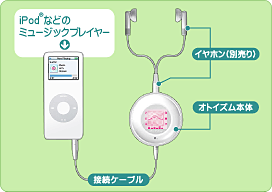 Konami showed Otoizm at the Tokyo Toy Forum, then released it in June 2006 . This pet needs to be fed music. You basically wire it in series with your MP3 Player and the pet grows according to what kind of music you feed it (it classifies music into 19 types). The entire system is enclosed in a Yo-Yo that also includes a special clip to hook to your back pocket. If your friend has one, your pets can “dance” together. Plus you can record your friend’s voice and a new pet named Kotobaizm, shows up.
Konami showed Otoizm at the Tokyo Toy Forum, then released it in June 2006 . This pet needs to be fed music. You basically wire it in series with your MP3 Player and the pet grows according to what kind of music you feed it (it classifies music into 19 types). The entire system is enclosed in a Yo-Yo that also includes a special clip to hook to your back pocket. If your friend has one, your pets can “dance” together. Plus you can record your friend’s voice and a new pet named Kotobaizm, shows up.
Posted in Musical | Comments Off on Otoizm Yo-Yo from Konami
 Launched with a press release back on 26 April 2007, Mattel’s Barbie Girls is taking the world by storm. Girls can create their own character, design a room, shop, play games, listen to music and communicate with other girls.
Launched with a press release back on 26 April 2007, Mattel’s Barbie Girls is taking the world by storm. Girls can create their own character, design a room, shop, play games, listen to music and communicate with other girls.
Although Barbie is facing tough competition from Bratz in the stores, she’s winning strong online. In mid July Mattel is reporting Barbie Girls reached 3 million registered users in 60 days, making it the fastest growing virtual community ever. Plus they are currently adding over 50,000 new members a day!
Some are comparing Barbie Girls fast rise to that of Second Life which took three years to hit a million users.
Posted in Business, Dolls, People, Virtual Communities | Comments Off on Barbie Girls hits 3 Million Registered Users
Proctor and Gamble lets women design the perfect man and keep him in an aquarium on their desktop. Manquarium asks for your name, lets you pick from some body types, gives you the opportunity to upload a photo of your boy friends face to stick on him, then asks you a few questions about where you go for a perfect date, what kind of presents he would bring you for your birthday, how he would cheer you up, and how he should compliment you.
Its a nice way to develop a relationship with their customers and push a few products in the background. Your “man” swims in his aquarium, raps on the glass, and compliments you.
Objects in the background of the aquarium seem to change depending on your answers to the questions.  He is sort of a virtual pet, but doesn’t need any care, he just lavishes his “owner” with compliments.
Posted in Uncategorized | Comments Off on Manquarium
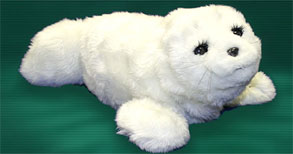
PARO is a Mental Commitment Robot. They are designed to interact with humans and encourage formation of emotional bonds between human and virtual pet. Their purpose is to provide psychological effects (like relaxation and motivation), physiological effects (like improvements in the human’s vital signs), and social effects (like encouraging communication between patients and caregivers in nursing homes).
PARO is a baby Harp seal, like those from north eastern Canada. Seals were chosen as a model instead of cats or dogs because people are very familiar with the movements and behaviors of cats and dogs. After a little while with a robotic cat or dog, they tire of it because they can tell it does not replicate real life. By using a seal, an animal most people know of, but have little experience with, the minor imperfections in modeling the animal are overlooked. This leads to a higher probability of forming a relationship with PARO.
In addition PARO can go where other pets cannot go. Many nursing homes do not allow “real” pets but do allow PARO.
PARO is an autonomous robot that can express surprise and happiness. It detects light, touch, temperature, posture and presence. PARO can also detect words, the direction they came from, and can be trained. He makes noises like a real baby seal and his fur is antibacterial and soil resistant. PARO’s insides have an electromagnetic shield allowing people with pacemakers to use the robotic pet.
Dr. Tankanori Shibata invented PARO. The term PARO comes from Personal Robot. PARO is about 57 cm long and weighs 2.7 kg. It uses a 32 bit RICS chip and can run about 1.5 hours on a full battery charge.
You can learn more information about PARO from his web site.
Posted in Robotic Pets, Therapy Pets | Comments Off on PARO Mental Commit Robot
 CScout Japan reported on 30 June 2007 they saw Sega Toys’ new Private Ocean at the Tokyo Toy Show. Somewhat similar to Ant’s Life Studio, but it has over 100 different ocean creatures. Private Ocean becomes your own private ocean. You can change the background and the screen is backlit if different colors. It includes touch sensors (touching the top sensor gets the fish to swim together and spell out the date and time, touching the bottom sensor scares them off.
CScout Japan reported on 30 June 2007 they saw Sega Toys’ new Private Ocean at the Tokyo Toy Show. Somewhat similar to Ant’s Life Studio, but it has over 100 different ocean creatures. Private Ocean becomes your own private ocean. You can change the background and the screen is backlit if different colors. It includes touch sensors (touching the top sensor gets the fish to swim together and spell out the date and time, touching the bottom sensor scares them off.


 In 2006 Bandai released
In 2006 Bandai released 


 While some are pushing virtual pets toward the “Uncanny Valley” where they seem so real they become eirie and people back away from them, Bandai took the opposite tack with its
While some are pushing virtual pets toward the “Uncanny Valley” where they seem so real they become eirie and people back away from them, Bandai took the opposite tack with its  Bandai is now following up Cube World with
Bandai is now following up Cube World with  Konami showed
Konami showed  Launched with a
Launched with a 